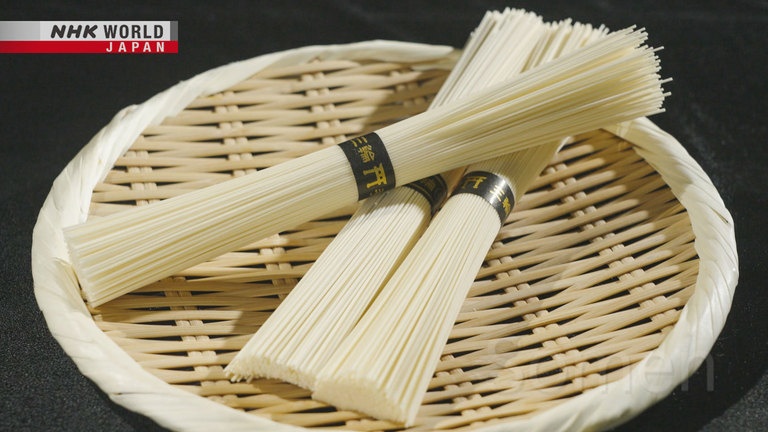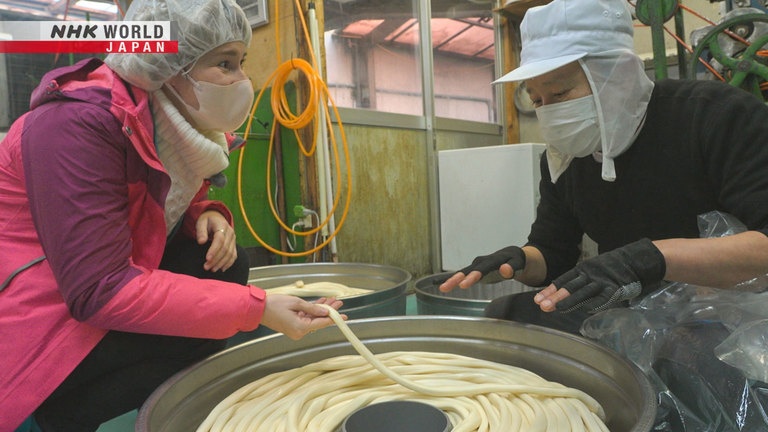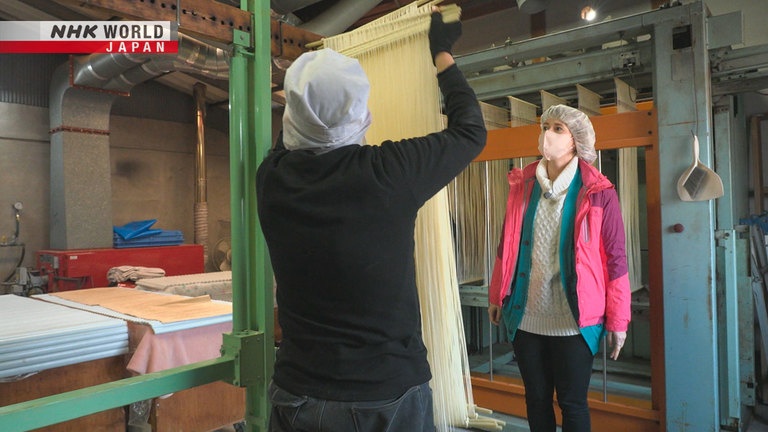SOMEN
Somen: these traditional Japanese noodles are amazingly thin and white. Japan has many noodles, like soba, udon and ramen, but the saga of somen goes back some 1,200 years. We visit Miwa, Nara Prefecture to see how traditional techniques are used to stretch somen again and again over a two-day period to achieve millimeter thinness. We also see how somen works in recipes from curry to Okinawan to even Italian with cheese and tomato sauce. Slurp into the history of somen! (Reporter: Saskia Thoelen)




Transcript
Tokyo: this world-class metropolis is a veritable gourmet wonderland.
Discover the stories behind the ingredients that make this city so delicious - so "oishii."
This time, our topic is "somen."
These traditional Japanese noodles are known for their white color and thin, almost string-like shape.
Japanese noodles like soba, udon and ramen are famous worldwide, but the saga of somen is especially long.
The history of these noodles stretches back some 1,200 years.
It really goes in very smoothly.
Mmm, nice. But there's still a bit of a chew to it.
So good.
Somen is produced using techniques handed down from generation to generation.
These thin, beautiful noodles are rooted deep in the lives of the Japanese, and favored as seasonal gifts.
It feels like it'll break in my hand. Wow.
- As thin as hair.
- Right!
Join us as we slurp up the story of the food said to have kicked off Japan's love of noodles: somen.
Trails to Oishii Tokyo.
Saskia, our reporter from Belgium, heads to a somen specialty shop in Tokyo.
Somen is often eaten at home, but this place gives people the chance to dine out on somen like they would with soba or udon.
First, the somen is boiled.
It's extremely thin, so about 90 seconds is all it needs.
Right after boiling, it's run through cold water.
This tightens the noodles up, giving them a firm texture.
The most popular style is "nyumen," warm somen served in a "tsuyu" broth made with "katsuo" stock and light soy sauce.
It's topped with "shiitake" cooked in soy sauce and sugar, plus green onion and nori seaweed.
They're so thin.
Wow. "Itadakimasu."
They go down so smoothly. "Oishii."
Perfect springiness. Not heavy at all.
They fill you up, but without a heavy feeling.
First off, they're gentle on the body.
That's what I like about them.
The springiness is also a big factor.
Plus the range of unique recipes you can make.
This shop has a number of original somen dishes.
Because the noodles are so simple, they match with a range of flavors.
Now that's versatility!
Somen noodles are shipped dry, and are produced with wheat flour.
To be labeled somen, the noodles must be under one-point-three millimeters thin.
Noodles made with the same wheat flour, but with a thicker diameter, are classified as "hiyamugi," udon, and so on.
Where are somen noodles made?
All around Japan.
But the most famous spot is Miwa in Nara.
It's time for a trip to Nara!
Nara is home to some 60 noodle factories.
The town of Miwa, in particular, is said to be where somen got its start roughly 1,200 years ago.
Every February, Miwa's Omiwa Jinja Shrine holds somen-related Shinto rituals.
In these rites, a priest draws lots to divine the market price for somen from Miwa that year.
I will announce the result of the divination.
The result is low cost.
This year, it was announced the word from the deities was that somen should be sold at low cost.
Makers use this result as a base for setting their prices for the year.
To the people of Miwa, somen is a sacred foodstuff.
Saskia heads for a store run directly by a maker of somen.
Welcome.
Usually, somen is sold in bundles of 50 grams, with two bundles making up one serving.
Look closely, and you'll see that the bands holding them together come in various colors.
Are these all the same type? Or are there many?
Many, sorted by thickness.
This is a common type called Homare.
It's about this thick.
This is Odamaki, which is thinner.
This is Kamisugi, the thinnest.
So thin!
The type called Kamisugi is just about zero-point-four millimeters in diameter.
Only a few artisans have enough skill to create these extremely thin noodles.
So thin! Scary.
Amazing.
As thin as hair, right?
Right!
It feels like it'll break in my hand.
Wow.
They're made so thin by kneading wheat
flour then stretching it out little by little.
Stretching it out?
That's right.
Somen's roots are said to be a stretched and twisted wheat flour food called sakubei, which came from China in the 8th century.
It's thought the people of Miwa gradually improved their flour kneading and stretching skills, creating the somen we know now by the 14th century.
Somen, the result of those finely polished techniques, was once a high-priced luxury, not a daily staple.
That's why it's still given as a traditional gift in Japan.
Saskia visits a restaurant near Omiwa Jinja Shrine to try the exceptionally thin noodles called Kamisugi.
They're boiled for just 20 seconds.
Then they're quickly washed and cooled in ice water.
This is a high-end version of a dish called "hiyashi somen," or chilled somen.
It's served with shiitake mushrooms simmered in soy sauce and sugar, wheat gluten, and strips of fried egg.
Look at that. Beautiful.
"Itadakimasu."
They're dipped into a tsuyu broth made with shiitake stock.
You would really think that because it's so thin that it wouldn't really have that much of a chew, but it does.
It's really nice, this nice chewy texture and the flavor, too, at the beginning you would think that it's not that much of a flavor but the more you chew,
the more that wheaty aroma comes to the foreground.
It's so so good, and then we have the tsuyu here, a bit strong in taste.
Really brings out that wheaty flavor much much more.
The balance is so, so good because it's delicious.
Somen is not only delicious, but apparently there's a really fun way to eat somen, and I wonder what that is, so let's find out.
Saskia's next stop is this restaurant on the road to the shrine.
Wow. This is so cool.
So you see the water is twisting around?
What is this?
Let the somen flow through here.
When they come around, grab them with your chopsticks,
dip them in broth, and eat them.
I'm nervous.
What? How fun.
This is "somen nagashi," or flowing somen.
It's popular with visitors from all over.
Just like that.
I did it.
- "Oishii."
- Thank you.
Very.
Nice and firm, right? That's somen for you.
Very springy.
Even running through water, the noodles retain their firm chew and springy texture.
They're not soggy at all.
Just how do they make somen noodles so firm and chewy?
I can't wait to find out.
Somen are made in the cold winter months, between November and March.
The key to their firm texture lies in the dry, cold air.
Work begins before dawn.
Saskia visits a somen factory founded all the way back in 1913.
- Good morning.
- Good morning.
You start so early.
Tamai Masanori is the fourth-generation head of this factory.
First comes dough production.
125 kilograms of wheat flour is thoroughly mixed with salt water.
Is the salt water always the same amount?
No, it changes based on temperature and humidity.
Colder days call for less salt. I adjust the water too.
It takes two days to make,
so it's up to today and tomorrow's weather.
Two days?
Right.
Making somen requires over 10 steps in total.
Tamai says that creating the dough requires the most concentration.
He must constantly check the stickiness and springiness by hand, carefully adjusting the amount of salt water along the way.
Such a delicate process.
Yes. It determines the quality of the noodles.
The most important step.
Right.
Once finished, the dough is moved into another machine where it's turned and compressed for about 30 minutes, giving it a smooth texture.
Once its surface is moist and smooth, it's cut into strips.
We stretch this.
Wow.
All the way to somen thinness.
Seriously? At this point?
No more cutting after this, just stretching.
To prevent drying, the strips are covered then left to rest for about 30 minutes.
They're then smoothed out and formed into rod-like shapes.
Brushed on is cottonseed cooking oil.
It prevents the dough rods from getting too dry or sticking to each other.
We have machines, but it's the same
process as when it was stretched by hand.
Let it rest, stretch. Repeat.
That's what makes it firm and chewy.
Let it rest then pull it thinner.
Yes.
It's so funny. I can't believe we only had three or four steps and we're already here. It's crazy.
Onto the next step.
Twisting while stretching.
Adding twists makes it stronger,
like rope.
- Like string?
- Right.
Twisting the dough gives it the strength to keep it from breaking even when it's stretched into millimeter-thin noodles.
It also gives it that distinctive somen mouthfeel.
Feel how springy it is.
Wow, so elastic.
We rest this for an hour or so,
then stretch it to half this thickness.
Half again? Wow.
So springy.
After the dough is rested for an hour, it's further twisted and rolled out on two poles in a figure eight pattern.
- It's like knitting!
- Right.
After a bit more stretching, that's it for day one.
All together, these steps took over 12 hours of work.
I can see why they start early in the morning!
This dough was made yesterday and left to rest overnight.
It needs to rest a night?
Yes. It ultimately needs to stretch
Two meters, so we let it mature overnight.
Wow!
This is crazy.
Look at this! So thin!
Next comes the final step, where the dough is stretched even further.
I can't believe that they stretch out so much. Almost like threads.
It's so cool to see.
After drying under fans for 90 minutes, the noodles are finally finished.
During this step, too, long poles are used to keep the noodles from sticking to each other.
The dried noodles are cut into even lengths and stored in wooden boxes in a warehouse for several months.
The noodles become even firmer as Japan's humid rainy season comes and goes.
The only ingredients used to make these noodles are wheat flour, salt water and a bit of cooking oil.
While machines are now a part of the process, the techniques behind somen, this key part of Japan's culinary culture, have been passed down virtually unchanged for centuries.
The somen-making techniques fostered in Miwa later spread nationwide.
One big factor were pilgrimages to Ise Jingu Shrine.
Pilgrims from all over Japan visited the shrine, and it's thought that on the road, they stopped in Miwa and learned about the charms of somen.
These days, regions all across Japan have their own unique takes on somen.
Saskia meets Ueda Tetsuya, who shares the fun of somen in recipe books and on social media.
- Check this out. Short, right?
- Right.
This is "shiroishi-umen," from Miyagi.
Half size, so easy to eat. Goes down easy.
- On the other hand, this is long.
- Quite long!
- It's all wrapped up.
- Not cut, huh?
Right. Stretched by hand, no machines.
Only one of its kind in Japan.
All by hand?
It's said there are a nearly uncountable number of these local somen varieties, showing how deeply rooted somen is in Japan's culinary culture.
Ueda shows Saskia some recipes that make use of somen's unique properties.
What a beautiful lineup.
- All finished.
- So pretty.
This is called curry nyumen.
It uses those short shiroishi-umen noodles.
- When you slurp, the soup doesn't go flying.
- Practical!
It's great.
Nice length. Easy to eat!
Delicious!
Curry and somen match well.
You can slurp it right down.
Sometimes when you make
curry you have a lot left over.
Just add noodle broth to make a soup
and add in some somen.
Great idea. The somen are light,
so you can eat a lot.
Yes.
Next up, somen chanpuru, from Okinawa.
This uses Okinawan somen called ryuto.
It's made especially for somen chanpuru.
The chewiness matches the rich flavor
of the oyster sauce. Perfect for this dish.
"Itadakimasu."
"Oishii!"
The noodles are front and center.
Sometimes you've got some bacon
or shimeji mushrooms in the fridge, right?
True.
You can make some tasty somen
dishes with those leftovers.
- So good.
- And easy to make.
Last, "tonjiru" - pork and veggie miso soup - with somen from Miwa.
Miwa somen has lots of firmness.
It retains that firmness even in warm soup.
Right.
It doesn't get soggy.
Somen is so thin, you think it
wouldn't stand out, but that's not true.
It's loud and proud.
"Oishii."
So many easy-to-make recipes.
Why not try them at home?
If there's a country known for great noodles, it's Italy.
What are some of the differences between pasta and somen?
To find out, Saskia visits an Italian restaurant in Tokyo.
Its owner and chef will use somen to create Italian dishes that "look similar, yet feel totally different" to pasta.
That chef, Hamasaki Ryuichi, is famed for bringing out the best of ingredients in his dishes, which combine familiar elements in innovative new ways.
Here you are. Chilled Miwa somen.
The somen, which has been chilled with ice water, is flavored with olive oil and a fresh tomato juice-based sauce.
Topped with sea urchin, this is one luxurious dish.
- "Itadakimasu."
- Go ahead.
- So good.
- Thank you.
Delightful.
The sea urchin is a perfect match.
The tomato sauce is so fresh.
It brings it all together.
Right. A tight package of flavor.
Indeed. So different than pasta.
Both the flavor and the texture.
Similar look, different dish, right?
A wholly different appeal.
There's some saltiness to the noodles,
and that makes it different too.
So much greatness concealed
within these noodles.
Right. Limitless potential.
Next up, some Italian home cooking, Hamasaki style.
Used to flavor the somen this time is free range chicken bouillon soup.
The garnish on the plate is Parmigiano Reggiano cheese, pepper and lime zest - all to be pushed into to the soup before eating.
Yes, just like that.
"Oishii."
Comforting flavor, right?
Yes, so gentle.
It's chicken soup, so not fatty.
- The cheese adds great freshness.
- Right.
And the somen's firmness appears again.
When somen is cooked and eaten
quickly, the firmness is especially clear.
- And you never get tired of it.
- It's true.
That's the most important point.
With more recipes, somen is bound
to become a worldwide hit.
Somen: brought to life through traditional techniques, these noodles are like edible works of art.
Japan's long history and culinary culture are packed into each and every one of those thin strands of somen.
In Tokyo, every ingredient has its own story.